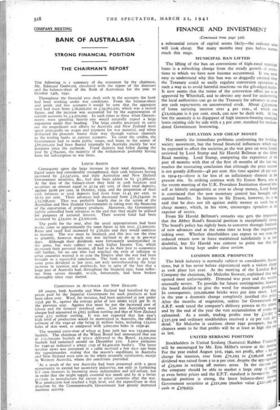COMPANY MEETING
BANK OF AUSTRALASIA
STRONG FINANCIAL POSITION THE CHAIRMAN'S REPORT
THE following is a summary of the statement by the chairman, Mr. Edmund Godward, circulated with the report of the directors and the balance-sheet of the Bank of Australasia for the year to October 14th, 1940.
Throughout the financial year dealt with in the accounts the bank had been working under war conditions. From the balance-sheet and profit and loss accounts it would be seen that the aggregate total had risen from £56,222,000 to £59,365,000, which was a record figure, and the increase was accounted for by the augmentation of current accounts by £4,300,000. In such times as these when Govern- ments were spending heavily one would naturally expect a large expansion under that heading. The large credits necessary to carry out the magnificent war efforts by Australia and New Zealand were spent principally on wages and payment for war material, and when disbursed the proceeds found their way through various channels to the trading banks as current accounts. To cover the credits, the Government had to make public issues, and loans to the extent of £66,000,000 had been floated internally by Australia mainly for war purposes since the outbreak. Fixed deposits had fallen during the year by £764,000, the majority of the withdrawals probably having been for subscription to war loans.
LIQUID ASSETS
Consequent upon the large increase in their total deposits, their liquid assets had considerably strengthened, their cash balances having increased by £2,547,000, and their Australian and New Zealand Government securities, &c., had also been added to by £1,386,000. At the date of the balance-sheet they held in cash balances and securities an amount equal to 45.54 per cent. of their total deposits, against 39.66 per cent. in October, 1939, and the proportion of their cash balances to total deposits had risen from 11.43 per cent. to 16.25 per cent. Their advances had decreased from £36,534,000 to £35,798,000. That was probably largely due to the action of the Australian and New Zealand Governments in taking over the financing of the exportation of primary products. Moreover, the Government rightly controlled bank advances to the end that they might be utilised for purposes of national interest. Their reserve fund had been increased by £25,000 to £2,500,000.
The profit for the year, after the usual appropriations had been made, came to approximately the same figure as last year, £1,5oo,000. Rates and taxes had increased by £36,000 and they would continue to increase. The war must be financed, and this was not the time to grumble, however much one was inclined to do so in pre-war days. Although their dividends were fortunately undiminished in the gross, but were subject to much higher Income Tax, which decreased their personal income, all had to do their best to economise still further, for no one who had watched the evils of inflation in other countries wanted it to ruin the Empire after the war had been brought to a successful conclusion. The bank was able to pay the same gross dividend as last year, not silly notwithstanding the large increase in taxation and overheads, but in spite of the fact that a large part of Australia had, throughout the financial year, been suffer- ing from severe drought, which, fortunately, had been broken thoroughly since 1941 started.
CONDITIONS IN AUSTRALIA AND NEW ZEALAND
Of course, both Australia and New Zealand had benefited by the prices paid by the Imperial Government for such products as had been taken over Wool, for instance, had been appraised at just under 131d. per lb., against the average price of just under iold. per lb. in the previous year. Against that must be put the increased cost of labour and the farmers' overhead costs. Last year Australia's wool cheque had amounted to L65f million sterling and that of New Aaland some Lis million sterling. It was not expected that last year's high level of production would be maintained in Australia, the official estimate of the 1940-41 clip being 3+ million bales, including 153,000 bales of skin wool, as compared with 3,600,000 bales in 1939-40.
The seasonal carry-over of wheat at June 30th last was 125,000,00o bushels. The chairman of the Wheat Board had announced that out of 195,700,000 bushels of wheat delivered to the Board, 25,200,000 bushels had remained unsold on December 31st. Latest estimates for 1940-41 indicated a wheat crop of 82,400,00o bushes. The latest weather news was contained in a cable received a few days ago from the superintenden staring that the season's conditions in Australia and New Zealand were now on the whole generally satisfactory, except in Western Australia, where dry conditions prevailed: • As a result of the war Australia had been presented with a great opportunity to extend her secondary industries, not only in furthering h.n- own interests in becoming more independent and self-reliant, but in order that she might supply essential war needs and be in a better position to manufacture for export to other countries after the war. War production had reached a high level, and the expenditure in that direction by the Commonwealtk Government had greatly increased business activity.






































 Previous page
Previous page